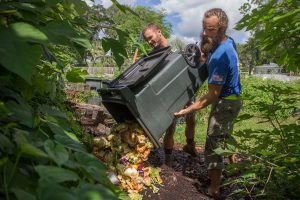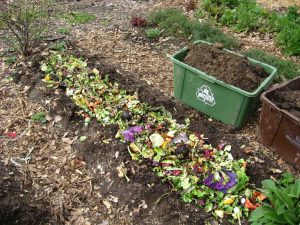
The Farm Bureau’s annual Thanksgiving price survey estimates that Thanksgiving Day accounts for $282 million of uneaten turkeys that end up in the trash. Added to our overall food consumption, we throw away 34 million tons of food each year. Not only does that have a massive impact on our greenhouse gas emissions (because as that material breaks down in the landfill, methane, a very potent greenhouse gas, is emitted). But it also adds to our overall waste when we take into consideration the resources needed to produce this material. The National Resources Defense Council (NRDC) breaks down our Thanksgiving Day waste like this: 204 million pounds of disposed, uneaten meat, accounts for 1 million tons of CO2 and 105 billion gallons of water. “Per pound, that is the equivalent of driving your car 11 miles and taking a 130-minute shower (at 4 gallons/minute).”
Reduce Waste
So what are some ways we can help reduce our waste and what gets sent to the landfills this Thanksgiving? Simply put, we can consume less. Over the past 40 years our portion sizes have grown exponentially and are 2 to 8 times higher than the USDA standard serving size recommendation. Also, consider creative ways for using all of those leftovers from turkey potpie, to leftover stuffing waffles, to bone broth. Lastly, don’t send any of those unused leftovers and food scraps to the landfill, bury them instead.

Trench Composting
Trench Composting is not a new concept. There is no turning piles, no concern of “greens” to “browns” ratio, and no fancy bins. Simply dig a trench to a minimum depth of 8 inches, add food scraps, and cover with soil. Over time, earthworms and microorganisms will convert that organic material into nutrient-rich soil. Meats, bones, and other no-no’s for your compost bin, can also be added into the trench, though it is recommended to bury those to a minimum of 12-18 inches, so you don’t attract any unwanted critters. After a couple of months, you can plant directly on top of that trench and be gifted with a healthy, thriving plant, growing off the nutrients produced by decomposed material that was diverted from the landfill and transformed into a healthy, living soil.
Fresh From Florida
Take your sustainability efforts a step further and Look for the Fresh from Florida™ logo whenever possible, to ensure you are purchasing food grown by one of Florida’s 47,000 agricultural producers. That includes shopping from the producers and growers here in the Florida Keys that offer locally grown produce and honey.
Happy Thanksgiving!
For more information:
NRDC Thanksgiving Day Facts: https://www.nrdc.org/experts/dana-gunders/thanksgiving-be-more-grateful-wasteful
Thanksgiving leftover recipes: https://www.foodnetwork.com/thanksgiving/leftovers/best-thanksgiving-leftover-recipes
Composting methods: https://sfyl.ifas.ufl.edu/sarasota/natural-resources/waste-reduction/composting/what-is-composting/methods/
 0
0
